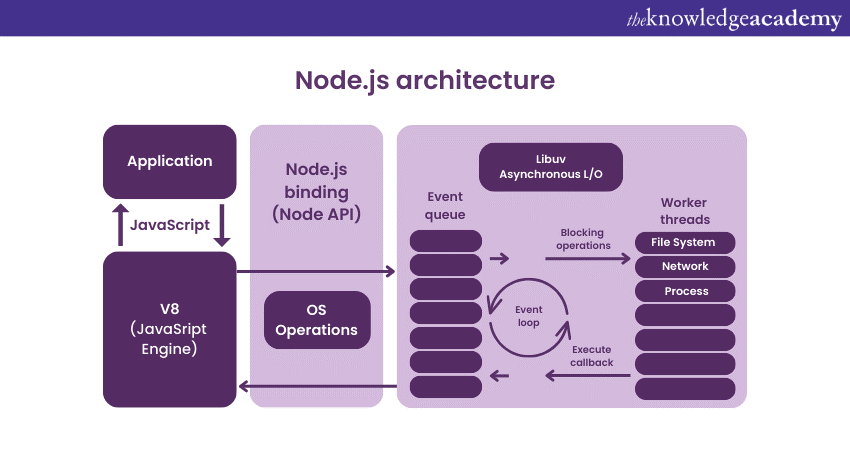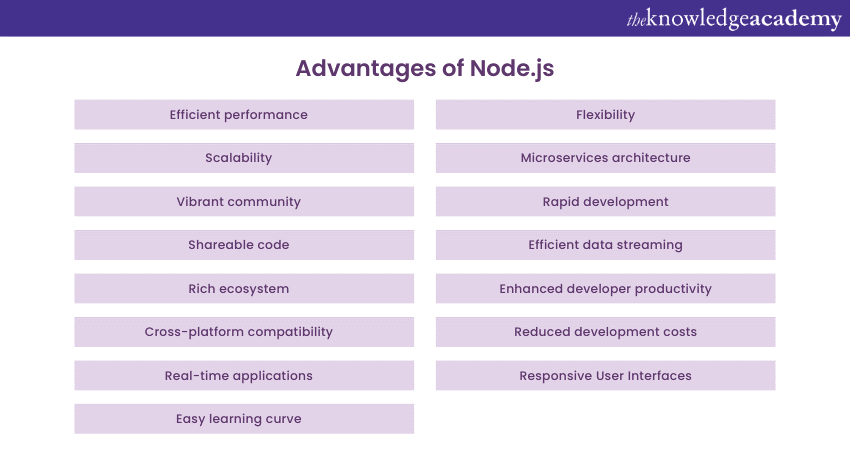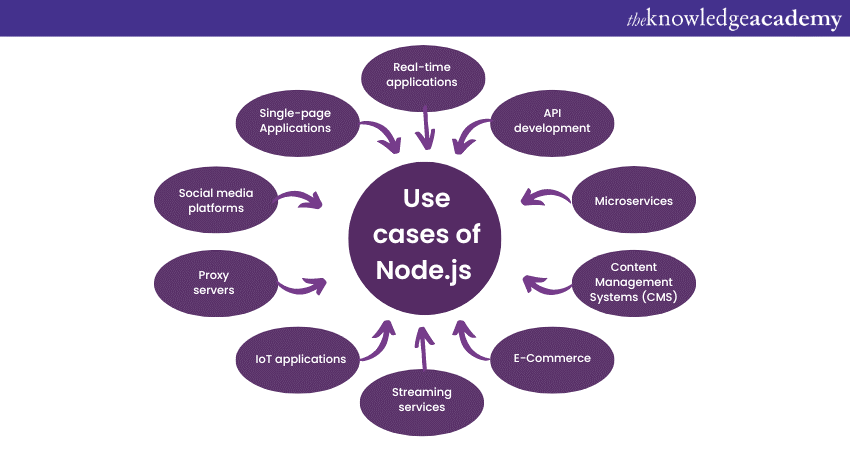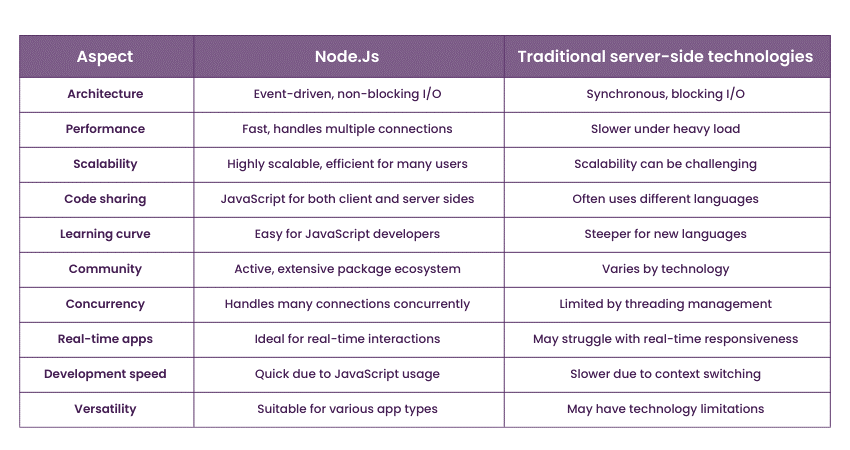We may not have the course you’re looking for. If you enquire or give us a call on +43 720 115337 and speak to our training experts, we may still be able to help with your training requirements.
Training Outcomes Within Your Budget!
We ensure quality, budget-alignment, and timely delivery by our expert instructors.

Node.js has revolutionised the world of Web Development, bringing forth a new era of efficient and dynamic server-side programming. Despite its popularity in the Web Development community, there are several novices unaware of the answer to “What is Node.js?”
According to W3Tech, Node.js is utilised by at least 30 million websites globally. In this comprehensive overview, we'll delve into “What Is Node.js?”, its key features, benefits, and its significance in modern Web Development.
Table of Contents
1) Node.js definition
2) Node.js architecture
3) Advantages of Node.js
4) Use cases of Node.js
5) Getting started with Node.js
6) Node.js vs. Traditional server-side technologies
7) Challenges and solutions
8) Community and resources
9) Future of Node.js
10) Conclusion
Node.js definition
Node.js is a powerful and versatile runtime environment that has redefined the landscape of Web Development. By allowing developers to use JavaScript on the server-side, Node.js has brought about a paradigm shift in the way applications are built and executed.
At its core, Node.js is an open-source runtime environment built on the V8 JavaScript engine, which was originally developed by Google for use in its Chrome browser. Node.js has the unique capability of executing JavaScript code on the server-side, enabling developers to create dynamic and responsive applications outside the confines of web browsers.
Node.js thrives on an Event-driven architecture, where actions are triggered by Events rather than following a linear execution flow. This approach is especially beneficial for real-time applications where rapid updates and interactions are essential. The architecture's non-blocking I/O ensures that applications can handle numerous concurrent connections without slowing down or freezing.
One of Node.js's standout features is its exceptional speed. The V8 engine compiles JavaScript into machine code, resulting in remarkably fast execution times. This speed, combined with Node.js's ability to handle a large number of connections concurrently, makes it a preferred choice for applications requiring real-time updates, like chat applications and online gaming platforms.
Moreover, Node.js boasts a rich package ecosystem, made accessible through the Node Package Manager (NPM). This vast collection of pre-built modules and libraries simplifies development, as developers can leverage existing solutions for various functionalities instead of building everything from scratch.
Node.js's versatility extends to various application types. It excels in creating APIs due to its lightweight architecture and scalability. Additionally, Node.js is well-suited for microservices architecture, which involves breaking down applications into smaller, manageable components that work together seamlessly.
Node.js has fundamentally altered the way developers approach server-side programming. Its Event-driven architecture, non-blocking I/O, remarkable speed, and rich package ecosystem make it an essential tool for modern Web Development. As technology evolves, Node.js's future remains bright, with its integration with emerging technologies likely to further enhance its capabilities and applications.
Node.js architecture

Node.js, a game-changing technology in Web Development, is celebrated for its unique architecture that offers unprecedented efficiency and scalability. At the core of Node.js lies its Event-driven architecture, a paradigm that drives its exceptional performance and responsiveness.
Node.js employs an Event-driven programming model, which fundamentally revolves around the concept of Events and Event handlers. In this architecture, the execution of a program is guided by a continuous loop known as the "Event loop." This loop monitors Events and delegates specific actions, or Event handlers, to be executed in response. This design allows Node.js to handle numerous tasks simultaneously without getting bogged down by waiting for one task to complete before proceeding to the next.
One of the foundational components of Node.js architecture is its non-blocking I/O model. In traditional server-side programming, operations are executed in a sequential, blocking manner. Node.js departs from this approach by adopting non-blocking I/O, enabling it to efficiently manage multiple concurrent connections.
When I/O operations, like reading from a file or making a network request, are initiated, Node.js doesn't wait for the operation to complete before moving on. Instead, it delegates the operation to the background, allowing the event loop to continue processing other tasks. This leads to a highly responsive application that can handle a large number of connections without significant delays.
The Event-driven architecture and non-blocking I/O model collectively contribute to Node.js's ability to excel in real-time applications, where rapid data processing and instantaneous responses are essential. Whether it's powering online gaming platforms, collaborative tools, or instant messaging applications, Node.js's architecture makes it an ideal choice for scenarios that demand real-time interactivity.
Node.js's architecture is a masterstroke in modern Web Development. By embracing an Event-driven approach and harnessing non-blocking I/O, it has transformed the way developers create dynamic and responsive applications. Its ability to handle numerous tasks concurrently while ensuring minimal delays makes Node.js a powerhouse in the world of server-side programming, and its impact on the Web Development landscape continues to be felt profoundly.
Unlock the world of Web Development with our comprehensive Node.js Developer Course – Join now and code your way to success!
Advantages of Node.js

Node.js has garnered immense popularity in the world of Web Development due to its numerous advantages. Let's explore these advantages in detail:
a) Efficient performance: Node.js's Event-driven, non-blocking architecture enables asynchronous programming, resulting in efficient handling of multiple concurrent operations. This leads to faster execution and better performance compared to traditional server-side technologies.
b) Scalability: Node.js is designed with scalability in mind. Its lightweight and Event-driven nature makes it fitting for building applications that need to handle many simultaneous connections. This makes it a great choice for real-time applications like chats and online gaming.
c) Vibrant community: Node.js boasts a robust and supportive community of developers, offering a wealth of resources, tutorials, and open-source modules through the Node Package Manager (NPM). This community-driven approach accelerates development by providing solutions to common challenges and fostering knowledge sharing.
d) Shareable code: With Node.js, developers can use the same programming language (JavaScript) for both server-side and client-side scripting. This allows for sharing code and logic between the two, reducing redundancy and improving maintainability.
e) Rich ecosystem: NPM, the package manager for Node.js, hosts a vast collection of open-source libraries and modules. Developers can easily find pre-built solutions for various functionalities, saving time and effort during development.
f) Cross-platform compatibility: Node.js supports multiple Operating Systems, giving developers the tools to build applications with the capability of seamlessly running across different platforms without major modifications.
g) Real-time applications: Node.js excels in creating real-time applications, where instant data updates are crucial. Its Event-driven architecture ensures that data changes are promptly reflected, making it ideal for collaborative tools, live dashboards, and social media platforms.
h) Easy learning curve: Developers familiar with JavaScript find it relatively easy to transition to Node.js, as the language remains consistent. This accelerates the learning process and reduces the barrier to entry.
i) Flexibility: Node.js allows developers to create both server-side and desktop applications. Node.js is versatile and this is showcased by its use cases wherein, applications ranging from command-line tools to even Internet of Things (IoT) applications can be built using it.
j) Microservices architecture: With the greater prevalence of microservices architecture, which allows applications to be divided into smaller and independently deployable services, Node.js offers a significant advantage. Its modular approach, combined with its ability to handle multiple concurrent connections, makes it ideal for building and maintaining microservices
k) Rapid development: Node.js's quick startup time, combined with its vast package ecosystem, accelerates development by providing tools and libraries that streamline common tasks.
l) Efficient data streaming: Node.js excels in handling data streaming, making it suitable for applications that deal with large volumes of data or need real-time video and audio processing.
m) Enhanced developer productivity: The ability to write both client and server code in JavaScript simplifies the development process, reducing context-switching for developers and improving productivity.
n) Reduced development costs: Node.js's efficiency in handling numerous connections and its ability to work with fewer resources can lead to cost savings in terms of infrastructure and server expenses.
o) Responsive User Interfaces: Node.js can be used to create highly responsive User Interfaces by handling data updates on the server side and pushing them to clients in real time, improving the overall User Experience.
Unlock the power of dynamic Web Design with our jQuery Introduction Course – elevate your coding skills today!
Use cases of Node.js

Node.js, with its unique architecture and capabilities, has found its way into a wide range of use cases in the world of Web Development and beyond. Let's explore some of the prominent use cases where Node.js shines:
a) Real-time applications: Node.js is a natural fit for building real-time applications that require instant data updates. Chat applications, collaborative tools, online gaming platforms, and live streaming services benefit from Node.js's Event-driven architecture, which enables seamless real-time interactions between users.
b) API development: Node.js is well-suited for creating robust and efficient APIs (Application Programming Interfaces). Its lightweight and scalable nature allows developers to build APIs that respond quickly to client requests, making it a popular choice for backend services of web and mobile applications.
c) Microservices: In the era of microservices architecture, where applications are broken down into smaller, independently deployable services, Node.js offers a significant advantage. Its modular approach, combined with its ability to handle multiple concurrent connections, makes it ideal for building and maintaining microservices
d) Content Management Systems (CMS): Node.js can power modern Content Management Systems that require real-time updates and interactions. It provides a dynamic and responsive User Experience, making it suitable for building CMS platforms that offer collaborative editing, live previews, and instant content updates.
e) E-Commerce: E-commerce platforms benefit from Node.js's speed and responsiveness. Its ability to handle a high volume of simultaneous connections ensures smooth user experiences, especially during peak shopping seasons or flash sales.
f) Streaming services: Node.js is a solid choice for building streaming platforms that deliver audio, video, or live broadcasts. Its efficient data streaming capabilities allow for smooth playback and minimal buffering, enhancing the User Experience.
g) IoT applications: Internet of Things (IoT) applications involve handling a multitude of devices and data points. Node.js's lightweight nature and ability to manage numerous connections make it suitable for building IoT backend systems that process and transmit data in real time.
h) Proxy servers: Node.js can be used to create proxy servers that act as intermediaries between clients and other servers. This is particularly useful for load balancing, caching, and security purposes.
i) Social media platforms: Social media platforms often require real-time updates, user interactions, and data feeds. Node.js's Event-driven architecture can handle the constant flow of data, making it a great choice for building responsive social networking sites.
j) Single-page Applications (SPAs): Node.js can power the backend of Single-page Applications, where dynamic content is loaded without the need for full page refreshes. This enhances the User Experience by providing fast and smooth interactions.
Unlock the power of dynamic Web Development with our comprehensive AngularJS Developer Course – Join Today!
Node.js vs. Traditional server-side technologies
Node.js has disrupted the landscape of server-side technologies, challenging the norms set by traditional options. Let's delve into the key differences and advantages that set Node.js apart from its predecessors

Performance comparison
Node.js's non-blocking architecture gives it a clear advantage in terms of performance. Traditional server-side technologies often use a synchronous, blocking approach, where each operation waits for the previous one to be completed. This can lead to bottlenecks and slower response times, especially when handling multiple concurrent connections.
On the other hand, Node.js's Event-driven, asynchronous nature allows it to handle multiple connections without waiting. This results in faster execution and better performance, making it a solid choice for applications that demand responsiveness and efficiency.
Scalability
Traditional server-side technologies can struggle with scalability, especially when faced with a large number of simultaneous connections. They often rely on threading or multiprocessing to handle these connections, which can be resource-intensive and lead to complex code.
Node.js's lightweight architecture, combined with its Event-driven approach, makes it inherently scalable. It can handle a significant number of concurrent connections with minimal resources, making it an ideal choice for applications that require scalability, such as real-time applications and microservices.
Code sharing and consistency
One of Node.js's strengths lies in the ability to use JavaScript for both server-side and client-side programming. This allows developers to share code and logic between the two sides, reducing redundancy and improving consistency. In traditional server-side technologies, developers might need to switch between different programming languages for the client and server sides, leading to a steeper learning curve and potential inconsistencies.
Learning curve
Node.js offers a relatively gentle learning curve for developers already familiar with JavaScript. This familiarity accelerates the transition to server-side development and reduces the time required to become proficient. In contrast, traditional server-side technologies might involve learning new languages, frameworks, and paradigms, adding to the learning curve.
Community and ecosystem
Node.js benefits from a vibrant and active community that continuously upgrades Node.js and contributes to its growth and improvement. This community-driven approach results in a plethora of open-source libraries, modules, and tools available through the Node Package Manager (NPM). Developers can easily find solutions to common challenges and leverage existing code, speeding up development and reducing reinvention.
Traditional server-side technologies might also have supportive communities, but Node.js's focus on JavaScript and its extensive package ecosystem give it an edge in terms of community engagement.
Unlock your creativity with our comprehensive Website Design Course and craft digital experiences that captivate and inspire.
Challenges and solutions in Node.js development
While Node.js offers numerous advantages, it also comes with its own set of challenges. However, the community and the technology itself have devised effective solutions to overcome these obstacles.
Challenge: Callback hell
Managing asynchronous operations in Node.js can lead to "Callback hell," where deeply nested callbacks become difficult to read and maintain. This can make the codebase convoluted and prone to errors.
To tackle Callback hell, developers can use Promises and Async/Await. Promises offers a more structured way to handle asynchronous tasks, making the codebase more readable. Async/Await further simplifies asynchronous code, allowing developers to write asynchronous operations in a synchronous style, enhancing clarity and maintainability.
Challenge: Scalability and memory leaks
Although Node.js is known for its scalability, improper handling of asynchronous operations can lead to memory leaks and decreased performance, especially in applications with long-running processes.
Developers must implement proper memory management practices and regularly monitor their applications for memory leaks. Utilising tools like heap analysers and profiling can help identify and rectify memory-related issues, ensuring optimal performance and scalability.
Challenge: Single thread limitations
Node.js's Single-threaded Event loop architecture can become a limitation when dealing with CPU-bound tasks. Heavy computational operations can block the Event loop, causing delays and affecting the responsiveness of other requests.
To address single-thread limitations, Node.js offers Worker Threads and clustering capabilities. Worker Threads allow developers to offload CPU-intensive tasks to separate threads, ensuring the main Event loop remains responsive. Clustering involves creating multiple instances of the application to utilise multiple CPU cores, enhancing overall performance.
Challenge: Error handling
In Node.js, unhandled errors can crash the entire application, affecting User Experience and system stability.
Developers should implement comprehensive Error-handling mechanisms, including try-catch blocks and Error-handling middleware. Additionally, frameworks and libraries often provide Error-handling features to streamline the process and ensure graceful degradation in case of errors.
Challenge: Lack of strong typing
JavaScript, the language powering Node.js, is dynamically typed, which can lead to runtime errors due to type mismatches.
TypeScript, a superset of JavaScript, introduces strong typing and static analysis to the development process. By using TypeScript with Node.js, developers can catch type-related errors during development, enhancing code quality and reducing runtime errors.
While Node.js presents its own set of challenges, it also provides effective solutions to address them. By utilising best practices, adopting appropriate tools, and staying engaged with the community, developers can harness the full potential of Node.js while mitigating potential pitfalls.
Master dynamic Web Development with our JavaScript & jQuery Course - Unlock interactive Websites today!
Community and resources
Node.js boasts a vibrant and supportive community that plays a prominent role in its growth and success. This dynamic ecosystem provides a wealth of resources and tools that empower developers to excel in their projects.
The Node.js community is a diverse network of passionate developers, enthusiasts, and experts who actively engage in knowledge sharing, discussions, and collaboration. Online forums, social media groups, and developer meetups create platforms for exchanging ideas, seeking assistance, and staying updated on the latest trends and developments.
One of the cornerstones of the Node.js community is the Node Package Manager (NPM). NPM hosts a vast repository of open-source libraries, modules, and packages that cater to a wide range of functionalities. This extensive package ecosystem accelerates development by offering pre-built solutions for common challenges, allowing developers to focus on crafting unique features rather than reinventing the wheel.
Additionally, the official Node.js website provides comprehensive documentation, tutorials, and guides that cater to developers of all levels. These resources simplify the learning curve and facilitate the exploration of Node.js's capabilities, from setting up the environment to mastering advanced techniques.
The collaborative spirit of the Node.js community, coupled with the rich pool of resources and tools, empowers developers to overcome challenges, enhance their skills, and create innovative solutions that drive the evolution of Web Development.
Unlock the power of collaboration with our Git & GitHub Fundamentals Course – master Version Control and enhance your coding journey!
Future of Node.js
As the technology landscape continues to evolve, Node.js remains on a promising trajectory, poised to play an integral role in shaping the future of Web Development. The foundation of Node.js's success lies in its architecture, community, and adaptability.
Node.js is expected to experience continued growth and adoption due to its efficient, Event-driven architecture that aligns well with the demands of modern web applications. Its ability to handle numerous connections concurrently, coupled with its lightweight nature, positions it as a strong contender in an increasingly interconnected digital world.
Moreover, Node.js is likely to seamlessly integrate with emerging technologies, further enhancing its capabilities. As technologies like WebAssembly gain prominence, Node.js can harness their power to create even more powerful and dynamic applications.
The dynamic and supportive Node.js community is another catalyst for its future success. With developers constantly contributing to its growth through open-source projects, discussions, and shared knowledge, Node.js is well-equipped to adapt to new challenges and opportunities that arise.
The future of Node.js looks promising as it continues to evolve, adapt, and align with the evolving needs of Web Development. Its architecture, community support, and potential integration with emerging technologies position it as a valuable asset in building the next generation of efficient, responsive, and innovative web applications.
Conclusion
In summary, Node.js is a transformative technology that redefines Web Development. Its Event-driven architecture, scalability, and vibrant community make it an indispensable tool. So, next time when you’re bogged down with, "What is Node.js?" Remember, it's the driving force behind modern, efficient, and dynamic online experiences.
Unlock your potential with comprehensive App & Web Development training for a brighter digital future!
Frequently Asked Questions
Upcoming Programming & DevOps Resources Batches & Dates
Date
 Introduction to HTML
Introduction to HTML
Fri 24th Jan 2025
Fri 28th Mar 2025
Fri 23rd May 2025
Fri 25th Jul 2025
Fri 26th Sep 2025
Fri 28th Nov 2025







 Top Rated Course
Top Rated Course



 If you wish to make any changes to your course, please
If you wish to make any changes to your course, please


